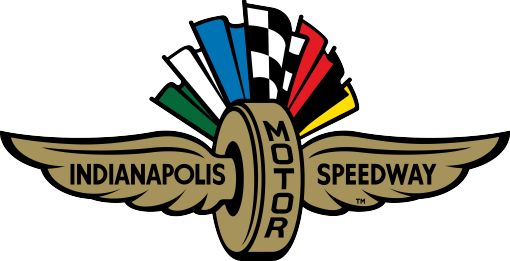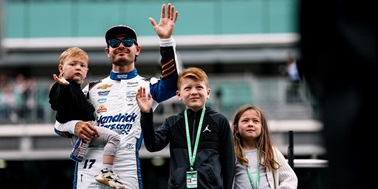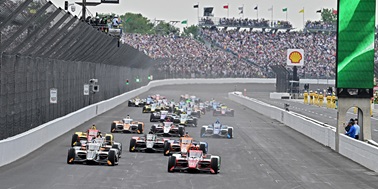But one of the Germans’ other secret weapons was streamlining. In addition to the open-wheel Grand Prix cars, Mercedes-Benz and Auto Union created a series of highly successful fully enclosed streamliners that set international speed records.
Mercedes ushered in a new era of streamliners in 1954, when it re-entered Grand Prix racing with open-wheel and fully enclosed streamlined race cars designed for different types of tracks. Mercedes won the World Championship in 1954 and 1955 with these cars. A Mercedes-Benz W196 streamliner is permanently exhibited in the Indianapolis Motor Speedway Museum.
Some of the top builders of Indianapolis-type cars also experimented with streamliners in the post-war era.
Master mechanics and innovators Jim Travers and Frank Coon chalked out a new car on the floor of their Torrance, California, shop for car owner Howard Keck to enter in the 1952 Indianapolis 500. The design offset and lowered the engine and surrounded the driver with a high-sided cockpit, creating the first Indianapolis “roadster.” Built by Frank Kurtis and driven by Bill Vukovich, the car revolutionized racing at Indianapolis.
After leading 150 laps in 1952 and winning with the car in 1953 and 1954, Travers and Coon undertook development of a streamliner for Vukovich to race, powered by a supercharged V8 engine. The car resembled a single-seat sports car. The body was designed by Norman Timbs, aided by the wind tunnel at Cal Tech, and built by fabricator Quin Epperly. The car appeared on Indy 500 entry lists but never competed.
Not one, but two different streamliners did compete in the 1955 500-Mile Race. Epperly built one for car owner Sandy Belond that was entered as the Belond-Miracle Power Special and driven by Jim Rathmann. The car combined a sleek roadster-style body with pannier side pods and streamlined fairings behind the rear wheels. The car arrived at the Speedway with a fully enclosed cockpit but raced without the canopy. Rathmann qualified 29th and finished 14th.
Frank Kurtis built the Sumar Special for Terre Haute, Indiana, car owner Chapman Root. The Sumar Special was even more radical than the cars built by Travers and Coon or Epperly. A wide sports car nose pushed the air past full fenders covering all four wheels before it slipped over a streamlined tail. A Perspex canopy that blended into an aerodynamic fairing and ended in an upswept fin covered the cockpit. The car practiced nervously in this configuration, and driver Jimmy Daywalt asked to have the streamlined components removed before qualifying. The car qualified and raced shorn of the full-width nose, fenders, side pods and the wide tail, as well as the canopy. Only the fin remained. Daywalt started 17th and finished ninth in the reborn roadster.
These streamliners weren’t the first attempts at cheating the wind. As early as 1917, barnstormer Barney Oldfield had a special enclosed race car—known as the Golden Submarine—built by Harry Miller. Oldfield successfully raced the Sub for two seasons, but never at Indianapolis. The car was entered in the first post-World War I “500” in 1919 with the egg-shaped body removed in favor of an open body for driver Roscoe Sarles.
In 1926, Englishman Ernest Eldridge entered two low-slung racers at the Speedway that resembled airplanes more than the upright race cars of the day. One, driven by Douglas Hawkes, was distinguished by its extremely low height, accomplished by locating the frame under the axles. The driver sat very low in the car, with his shoulders below the tops of the wheels.
Art Sparks, who would become part of Speedway legend, built a streamlined car with a low, “catfish” nose and tall tail fin for the 1932 race. The car was entered as the Gilmore Special and driven by H.W. Stubblefield. Although it might look like something from a Buck Rogers feature film today, the design resulted from a Stanford University engineering class study to design a streamlined race car.
But arguably the best-known streamliners in Speedway history were the cars built by Mickey Thompson for the 1963 and 1964 races. Thompson was a hot-rodder, who experimented with a series of streamlined drag racers and built a four-engine streamliner to capture the Land Speed Record. He reached a one-way speed of 406.6 mph in 1960 at Bonneville, but the car failed to make the required return run in the opposite direction to claim the record.
Thompson’s first car built for Indianapolis was a neat, rear-engine design driven by rookie Dan Gurney in 1962 and powered by a Buick V8. Thompson returned to the Speedway in 1963 with five cars, including the 1962 cars with the addition of pannier side tanks similar to the 1955 Belond-Miracle Power Special. The new cars, however, were revolutionary.
Thompson’s new cars were lower, with the side tanks artfully blended into the smooth bodywork that now covered a Chevrolet V8 engine. A wider nose extended toward the centerline of the front wheels. But the wheels and tires set the cars apart. Thompson designed the cars to ride on tiny 12-inch wheels mounted with wide tires specially developed by Firestone. The cars, entered as Harvey Aluminum Specials, immediately were dubbed “roller skates.” Only two of Thompson cars qualified. Al Miller finished ninth in one of the modified 1962 cars, and Duane Carter finished 23rd in the only “roller skate” to make the race.
Thompson returned in 1964 with three cars. As they arrived at the Speedway, the cars featured full-width noses and fenders that flowed over the front wheels. The side tanks curved up sharply at the rear to direct airflow over the wheels, although the rear wheels were not enclosed. Ford’s new DOHC Indy V8 powered the cars. Masten Gregory and rookie Dave MacDonald were assigned to drive two cars, with the third held in reserve.
Problems emerged immediately. Mechanic Peter Bryant, who later designed and built the successful Shadow Can-Am cars, described in his book “Can-Am Challenger” that Thompson hired him to work with the cars in 1964. The first challenge came when Thompson was required to use larger wheels than the cars were designed for. He chose to use 15-inch wheels of his own manufacture with tires specially made for his sponsor, Sears Allstate. The taller tires and wheels meant the cars rode and handled differently than the previous year.
The full-width nose and fenders over the front wheels created other challenges. The front ends alternately lifted and darted under braking. Bryant wrote that he worked on the suspension while “Mickey had the crew cut the tops out of the front fenders in an attempt to allow the air to escape.”
The changes worked immediately. Gregory never became comfortable with the car, but MacDonald qualified 14th fastest and veteran Eddie Johnson qualified 24th in a later qualifying session—although at nearly 2 mph faster. Sadly, MacDonald and Eddie Sachs were involved in an accident at the start of the second lap of the race that took the lives of both drivers. Johnson’s car was withdrawn four laps later with a failed fuel pump.
Despite vast developments in aerodynamics and speeds at the Speedway, the Thompson-Sears Allstate cars were the last streamliners to race in the Indianapolis 500. Rules today limit body width and prohibit enclosed wheels.




